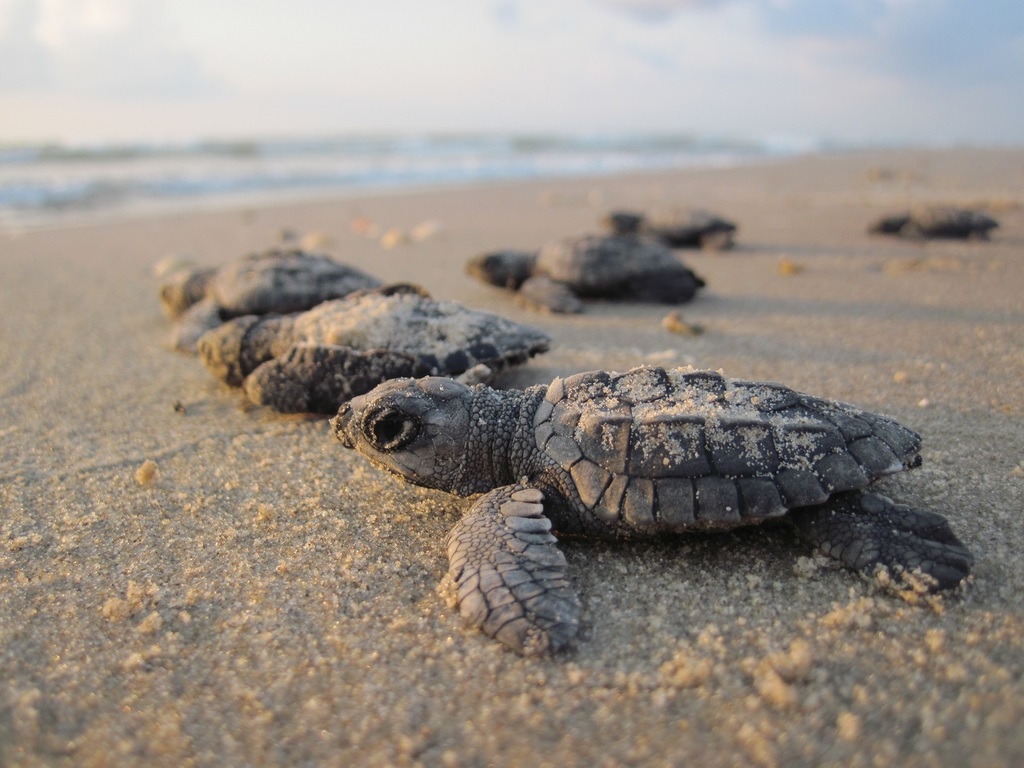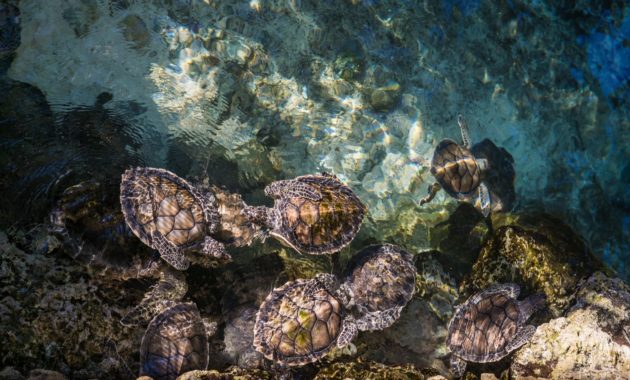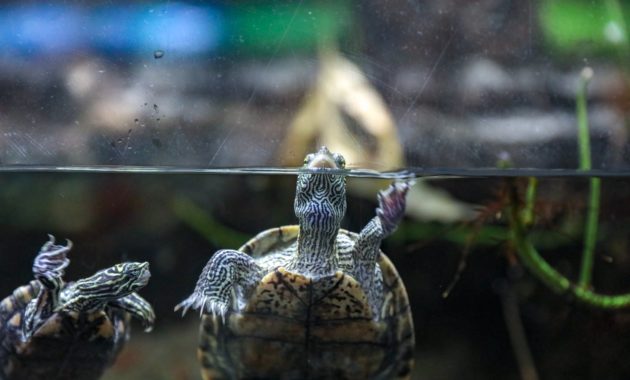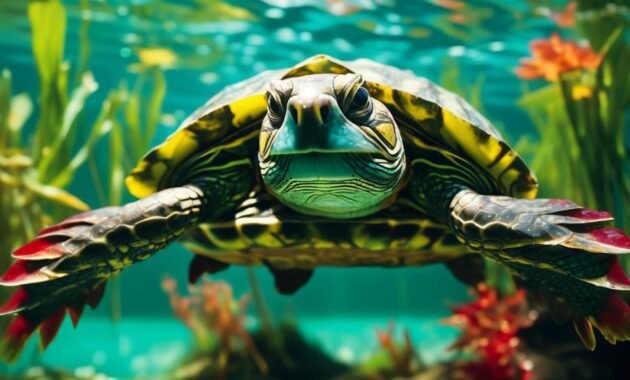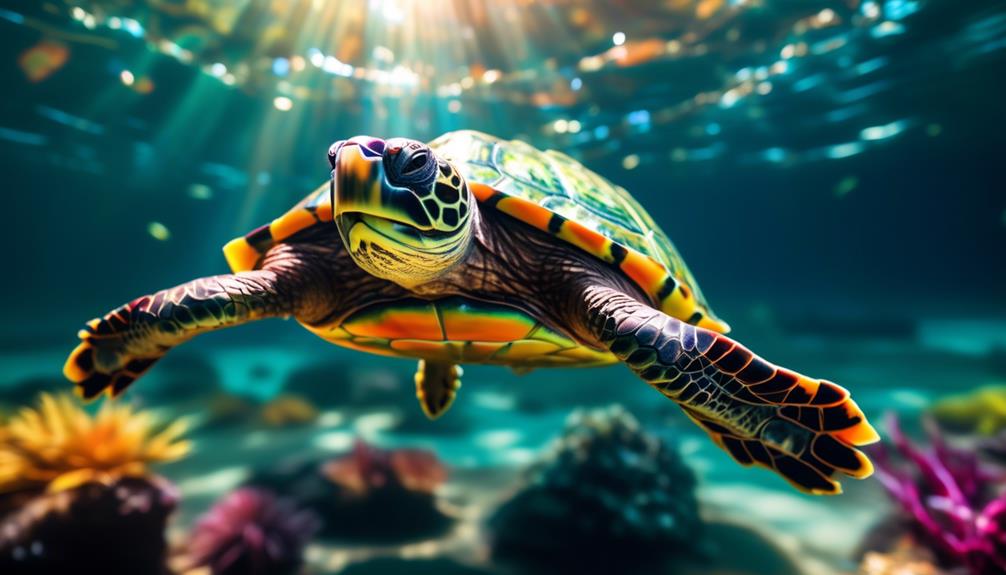
Step into the world of aquatic wonders, where nature’s palette comes alive in the form of the Reeves Turtle. Like a captivating artist’s brushstroke, this rare and colorful creature steals the spotlight with its vibrant hues and intricate patterns.
But there’s more to this turtle than meets the eye. As you embark on this journey, prepare to be enthralled by the mesmerizing details of its habitat, its unique shell characteristics, and its fascinating feeding habits.
So, get ready to uncover the secrets of the Reeves Turtle and witness the marvels that await you.
Key Takeaways
- Reeves turtles are small in size and have a lifespan of around 20 years.
- They are native to eastern and central China, South Korea, North Korea, Japan, and Taiwan, and prefer still or slow-moving water with aquatic plants and basking areas.
- Reeves turtles have a rectangular shell with three keels and distinct differences between males and females in terms of their plastron and tail.
- They have a range of colors and patterns, with olive green to tan or black carapaces, tan, yellow, or cream plastrons, and yellow stripes and speckling on their head and neck.
Size and Lifespan of Reeves Turtle
Reeves Turtles are small-sized aquatic creatures with varying lengths and a lifespan of around 20 years. These turtles are comparable in size to the Caspian Pond Turtle and the Chinese Stripe Necked Turtle. They require low maintenance care and make excellent pets.
Native to eastern and central China, South Korea, North Korea, Japan, and Taiwan, Reeves Turtles prefer still or slow-moving water with aquatic plants and basking areas. They can also be found in flooded rice paddies, marshes, and swamps.
With a rectangular shell featuring three keels, male and female Reeves Turtles differ in their plastron shape and tail length. The carapace color ranges from olive green to tan or black, while the plastron color is tan, yellow, or cream with dark smudges.
These turtles are friendly and can be housed with other turtles or similar breeds. Providing them with hiding places and enough space is crucial to their well-being.
Habitat and Description
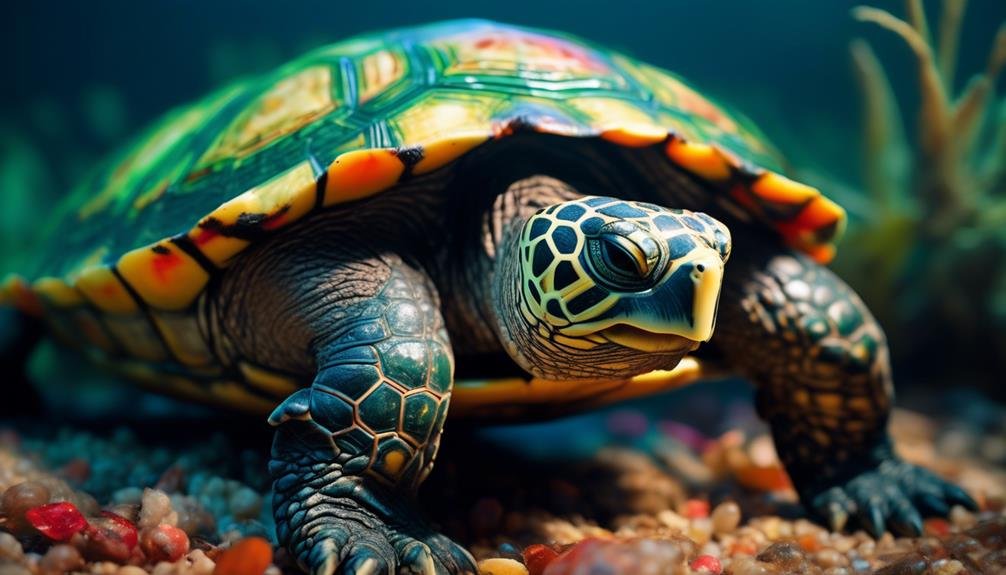
The habitat and description of the Reeves Turtle includes its natural range in eastern and central China, South Korea, North Korea, Japan, and Taiwan, as well as its preferred aquatic environments and distinctive physical features.
- Native range: eastern and central China, South Korea, North Korea, Japan, and Taiwan.
- Preferred habitats: still or slow-moving water with aquatic plants and basking areas, flooded rice paddies, marshes, and swamps.
- Physical features: rectangular shell with three keels, differences between male and female including convex or flat plastron in females, concave plastron and thicker/longer tail in males.
The Reeves Turtle thrives in various aquatic environments, from calm water bodies with aquatic plants and warm basking spots to flooded rice paddies, marshes, and swamps. It possesses a distinct rectangular shell with three keels. Gender differences are observable, with females having a convex or flat plastron, while males possess a concave plastron and a thicker and longer tail.
Understanding the Reeves Turtle’s preferred habitat and its unique physical features is crucial for providing them with suitable care and creating an environment that meets their needs.
Colors and Patterns
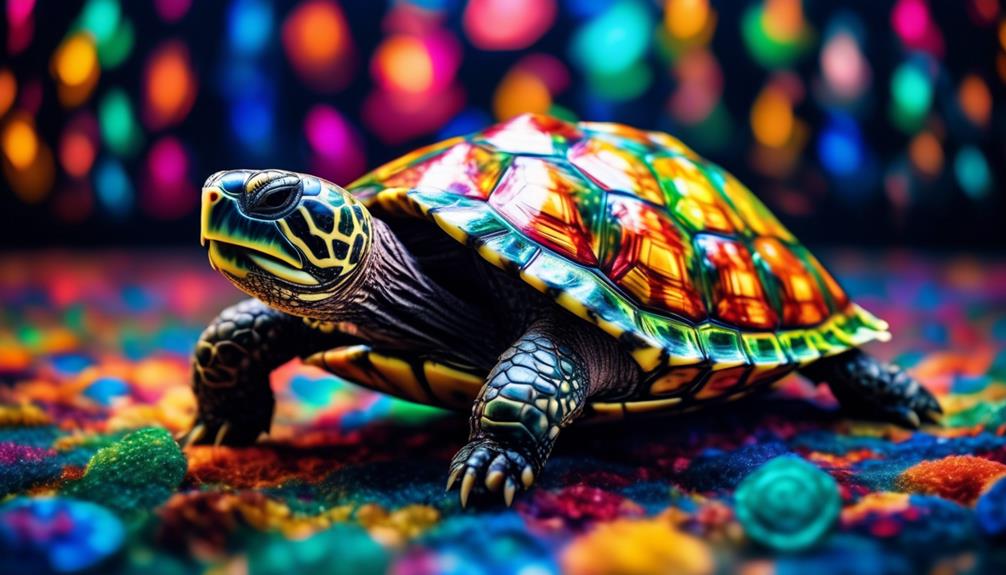
With a range of vibrant hues and intricate markings, the colors and patterns of the Reeves Turtle are truly captivating. The carapace of this rare and colorful species can vary from olive green to tan or black, while the plastron is typically tan, yellow, or cream with dark smudges. One of the most striking features is the presence of yellow stripes and speckling on the head and neck.
As the male turtles age, they may become darker in color. Additionally, the scales on their legs may display lighter hues. These beautiful colorations and patterns add to the allure of the Reeves Turtle, making it a visually stunning and remarkable creature to behold.
Environmental Requirements
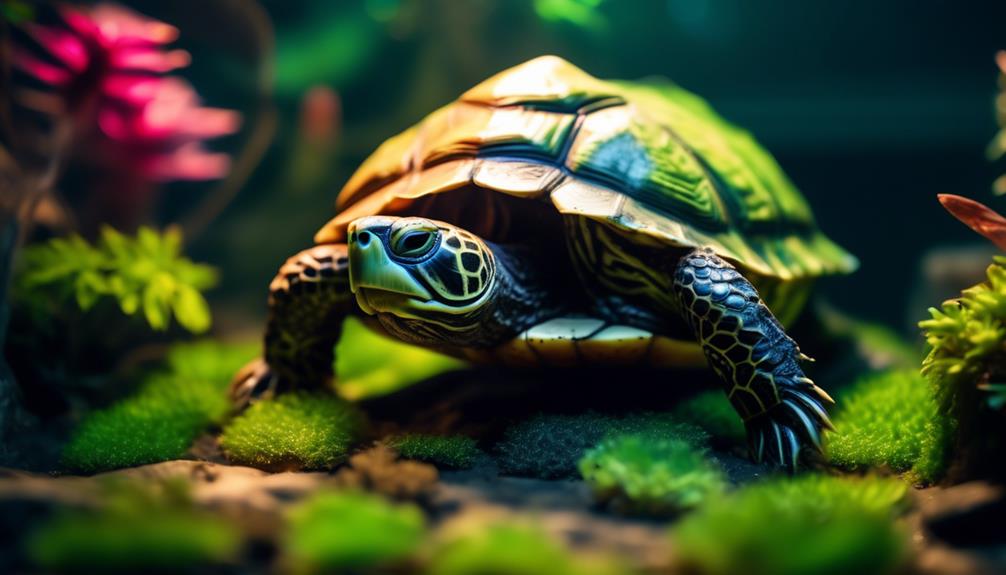
To ensure the well-being of your Reeves Turtle, it’s important to provide the appropriate environmental requirements. Here are three key factors to consider:
- Water conditions: Reeves Turtles prefer shallow water as they aren’t strong swimmers. Ensure the water is deep enough for the turtle to turn around comfortably. Additionally, a basking area with a UVB light and heater is necessary for their overall health and well-being.
- Temperature regulation: Maintain a basking temperature of 85-95F for the turtle to thermoregulate effectively. The water temperature should be kept between 70-80F to ensure their comfort and proper digestion.
- Substrate consideration: Choose a substrate that’s appropriate in size to prevent swallowing or difficulty in digestion. This will contribute to the turtle’s overall safety and well-being.
Care and Behavior
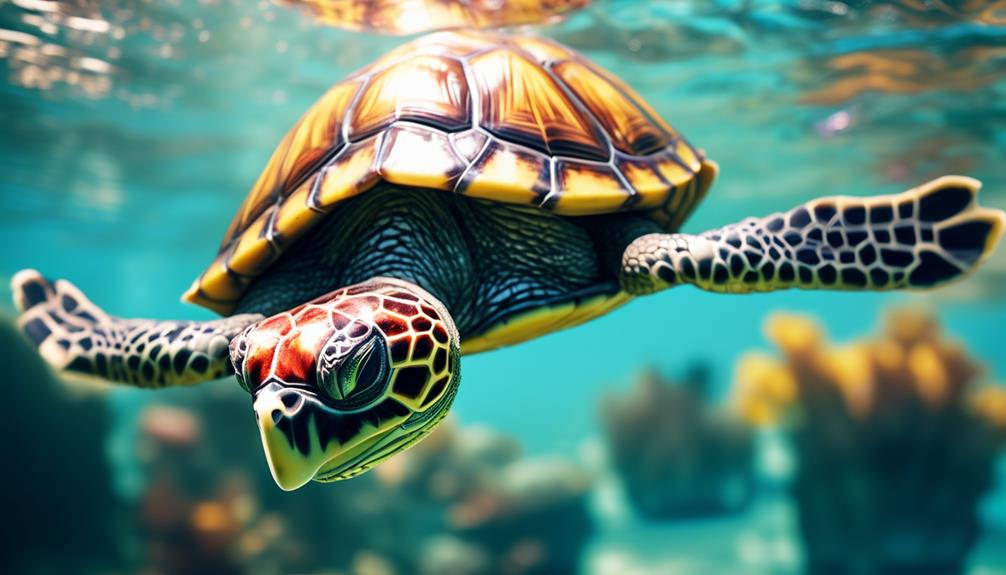
Now let’s explore the care and behavior of the Reeves Turtle, ensuring the well-being of this unique species as you provide them with the appropriate care and environment.
| Care and Behavior of Reeves Turtle | |
|---|---|
| Diet | Omnivorous diet including commercial pellets, insects, worms, fish, vegetables, and fruits. |
| Compatibility | Friendly personality and small size make them good pets. They can be housed with other turtles or similar breeds. |
| Aggression and Dominance | Males and females may exhibit territorial aggression and dominance. Providing hiding places and space is important. |
| Personality | Reeves Turtles have a friendly personality, making them enjoyable pets. |
| Size | Reeves Turtles are small in size compared to other turtle species. |
| Lifespan | They have a lifespan of 20 years. |
| Habitat Preference | They prefer still or slow-moving water with aquatic plants and basking areas. |
| Shell Description | Reeves Turtles have a rectangular shell with three keels. |
| Color and Pattern | Their carapace color ranges from olive green to tan or black, and the plastron color is tan, yellow, or cream with dark smudges. |
| Swimming Abilities | Reeves Turtles are not strong swimmers, so shallow water is recommended. |
| Basking Requirements | They require a basking area with UVB light and heater. The temperature should be 85-95F for basking and 70-80F for water. |
| Substrate | The substrate should be an appropriate size to prevent swallowing or easy digestion. |
Reeves Turtles are a low-maintenance and colorful species that can bring joy to any turtle enthusiast. By understanding their care and behavior, you can provide them with the appropriate diet, living conditions, and companionship they need to thrive.
Native Range of Reeves Turtle
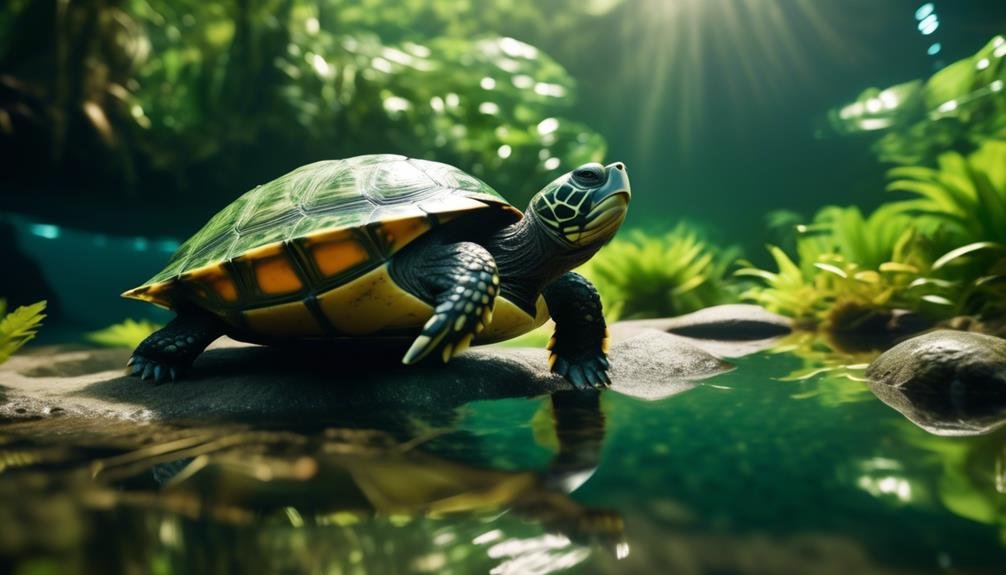
The Reeves Turtle is native to eastern and central China, South Korea, North Korea, Japan, and Taiwan. This turtle species has a wide distribution in Asia, and can be found in various habitats.
Here are three key points about the native range of the Reeves Turtle:
- Habitat preference: Reeves Turtles prefer still or slow-moving water with aquatic plants and basking areas. They can also be found in flooded rice paddies, marshes, and swamps.
- Geographical range: This species is found in eastern and central China, including regions such as Jiangsu, Zhejiang, and Fujian provinces. They’re also native to the Korean Peninsula (South Korea and North Korea), as well as Japan and Taiwan.
- Distribution variability: The Reeves Turtle has adapted to different regions within its native range, showcasing their ability to thrive in diverse environments. From the mountains of Taiwan to the rice fields of China, these turtles have successfully adapted to their surroundings.
Shell Characteristics
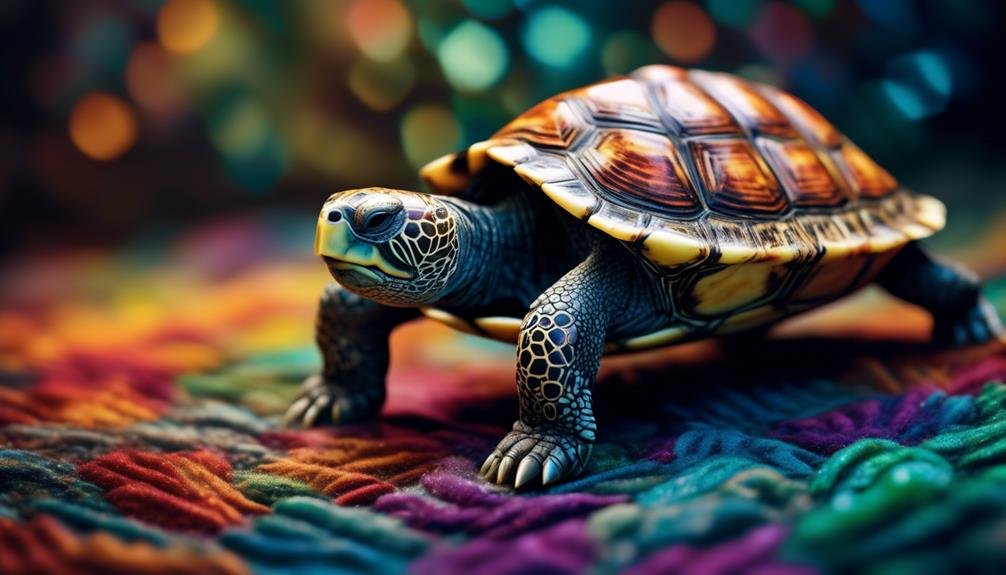
As we move on to discussing the shell characteristics of the Reeves Turtle, let’s explore the unique features that make this species stand out. The shell of the Reeves Turtle is rectangular in shape and has three keels. The carapace color can range from olive green to tan or black, while the plastron color is tan, yellow, or cream with dark smudges. Males may become darker in color as they age, and the scales on their legs may have lighter hues. It is also worth noting that there are differences between male and female turtles. Females have a convex or flat plastron, while males have a concave plastron and a thicker and longer tail. These distinct shell characteristics contribute to the unique appearance of the Reeves Turtle.
| Shell Characteristics |
|---|
| Rectangular shape |
| Three keels |
| Carapace color varies |
| Plastron color varies |
| Differences between male and female turtles |
Feeding Habits
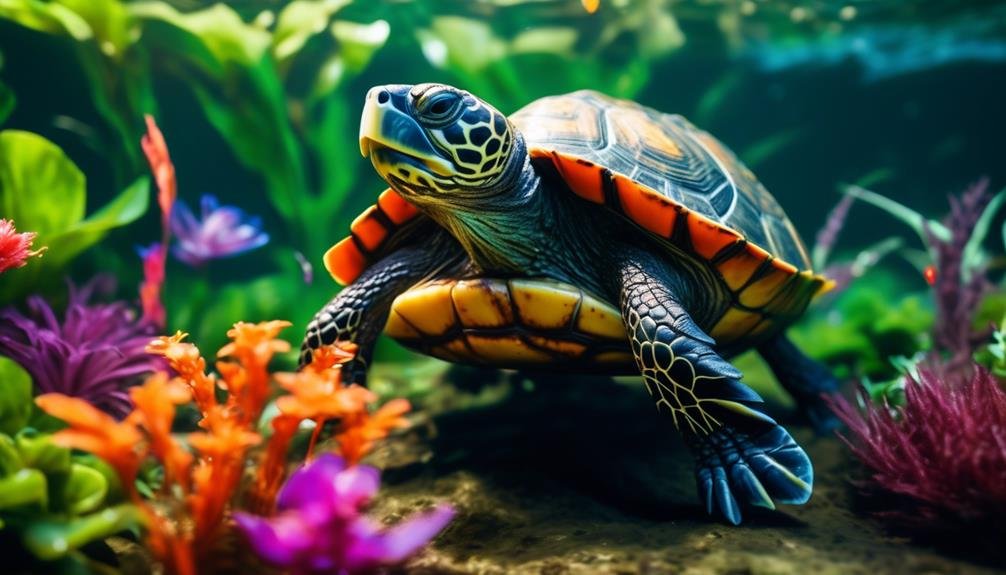
To properly care for a Reeves Turtle, it’s important to understand their feeding habits. Here are three key points to consider:
- Omnivorous Diet: Reeves Turtles have a varied diet that includes commercial pellets, insects, worms, fish, vegetables, and fruits. Providing a balanced mix of these food items will ensure their nutritional needs are met.
- Feeding Frequency: These turtles have a healthy appetite and should be fed daily. Younger turtles may require more frequent feedings, while adults can be fed every other day. It’s important to monitor their eating habits and adjust the feeding schedule accordingly.
- Supplementary Calcium: Reeves Turtles require calcium for strong shells and overall health. Dusting their food with calcium supplements or providing calcium-rich foods, such as cuttlebone, will help meet their calcium requirements.
Compatibility With Other Turtles
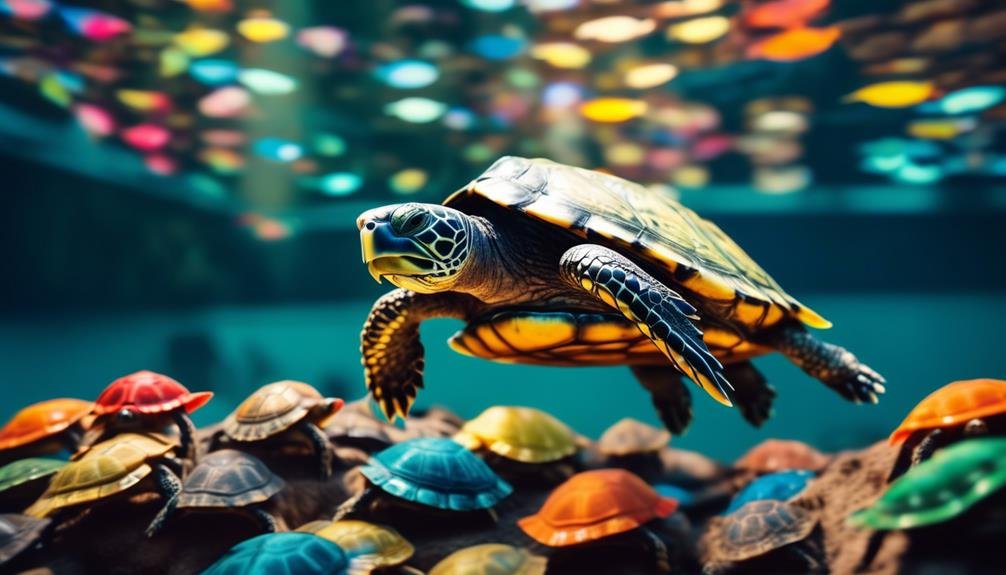
Understanding the compatibility of Reeves Turtles with other turtle species is essential for creating a harmonious and engaging environment for these colorful reptiles.
Reeves Turtles can be housed with other turtles or similar breeds, thanks to their friendly personality and small size. However, it’s important to note that males and females may exhibit territorial aggression and dominance.
To ensure a peaceful coexistence, providing hiding places and ample space is crucial. It’s advisable to monitor their interactions closely to prevent any harm.
With proper care and attention, Reeves Turtles can thrive in a community tank, contributing to a vibrant and diverse aquatic ecosystem.
Tips for Keeping Reeves Turtles as Pets
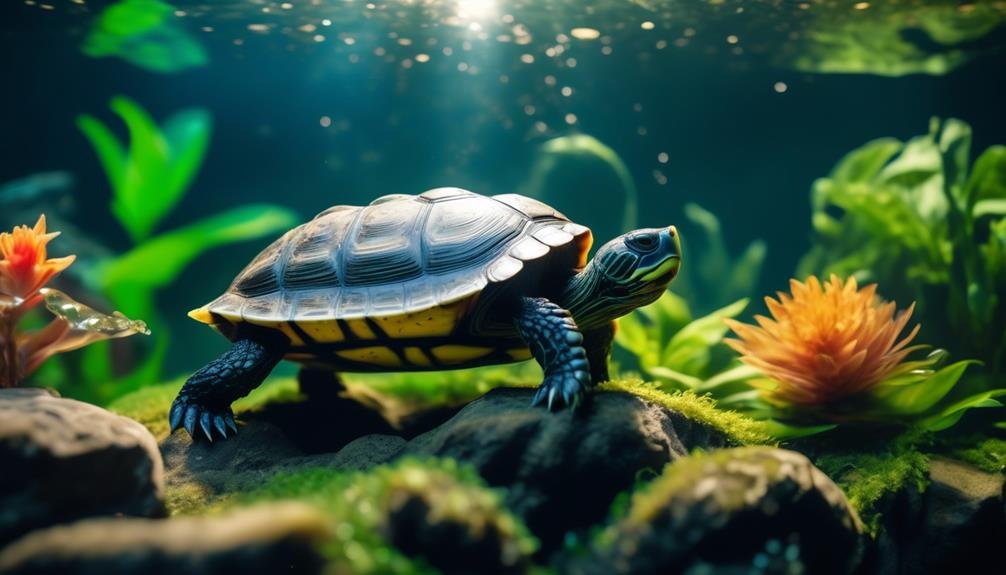
Keeping Reeves Turtles as pets requires proper care and attention to ensure their well-being and happiness. Here are some tips to help you provide the best care for your pet:
- Create the right habitat: Set up a tank with still or slow-moving water, aquatic plants, and basking areas. Make sure the water is shallow enough for the turtle to turn around and provide a basking area with UVB light and a heater.
- Maintain the right temperature: Keep the basking area at a temperature of 85-95F and the water temperature between 70-80F.
- Feed a balanced diet: Offer a variety of food including commercial pellets, insects, worms, fish, vegetables, and fruits. Make sure the food is appropriate in size to prevent swallowing or digestion issues.
Frequently Asked Questions
How Can I Determine the Gender of a Reeves Turtle?
To determine the gender of a Reeves turtle, look for a convex or flat plastron in females and a concave plastron with a thicker/longer tail in males. These characteristics can help you distinguish between the two genders.
Can Reeves Turtles Live in a Freshwater Aquarium?
Yes, Reeves turtles can live in a freshwater aquarium. They prefer still or slow-moving water with aquatic plants and a basking area. Ensure the water is deep enough for them to turn around and provide a basking area with UVB light and a heater.
Are There Any Specific Plants That Are Recommended for the Habitat of Reeves Turtles?
Yes, there are specific plants recommended for the habitat of Reeves turtles. They prefer aquatic plants like water lettuce, water hyacinth, and duckweed. These plants provide shade, hiding spots, and food sources for the turtles.
How Often Should I Clean the Water in the Turtle’s Tank?
You should clean the water in your turtle’s tank at least once a week. Regular cleaning helps maintain a clean and healthy environment for your turtle, preventing the buildup of waste and bacteria.
Are There Any Specific Health Issues That Reeves Turtles Are Prone To?
Reeves turtles are prone to specific health issues. These can include respiratory infections, shell rot, and vitamin deficiencies. Regular check-ups with a reptile veterinarian, proper diet, and maintaining clean water are important for their overall health.
What Makes the Reeves Turtle Stand Out Compared to the Alabama Map Turtle?
The elusive Alabama map turtle is known for its unique yellow markings and distinct red eyes. On the other hand, the Reeves turtle stands out with its strikingly bright yellow and orange markings on its head and neck. These unique features make the Reeves turtle easily distinguishable from the elusive Alabama map turtle.
Conclusion
In conclusion, the Reeves Turtle is a truly captivating and unique creature. With its vibrant colors, distinct patterns, and interesting behaviors, this small-sized turtle is sure to steal the spotlight.
Whether you’re fascinated by its rectangular shell, its range of coloration, or its compatibility with other turtles, the Reeves Turtle is a rare and colorful species that will amaze and delight any turtle enthusiast.
So why not dive into the fascinating world of the Reeves Turtle and make it your next pet?

